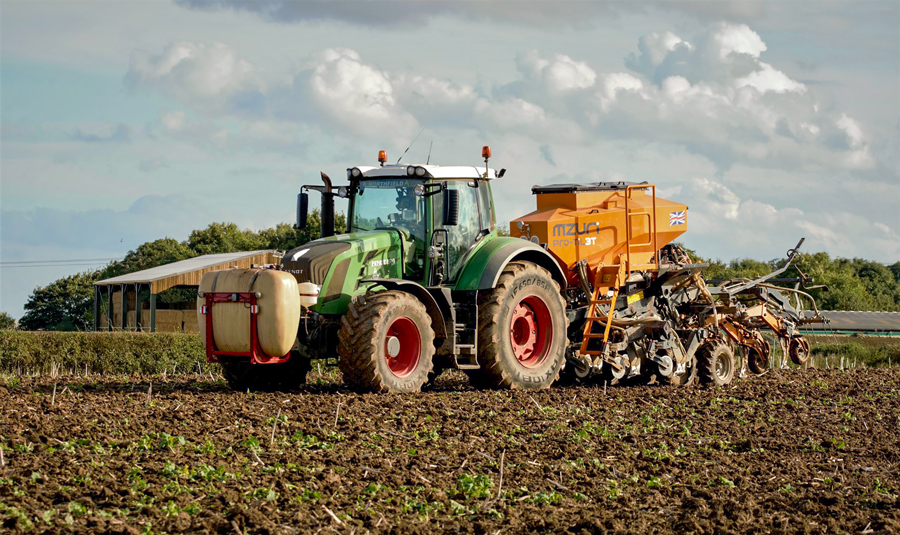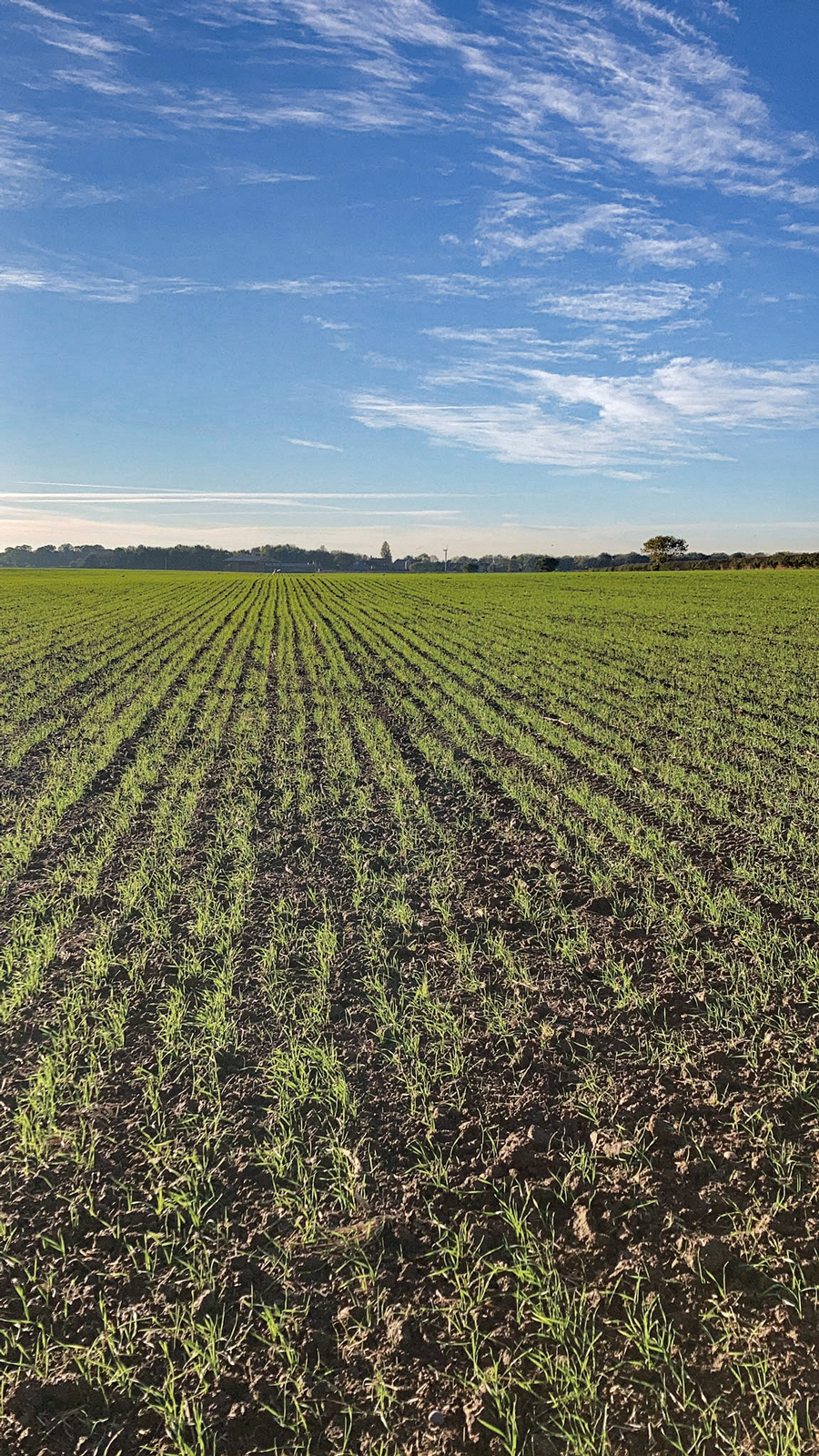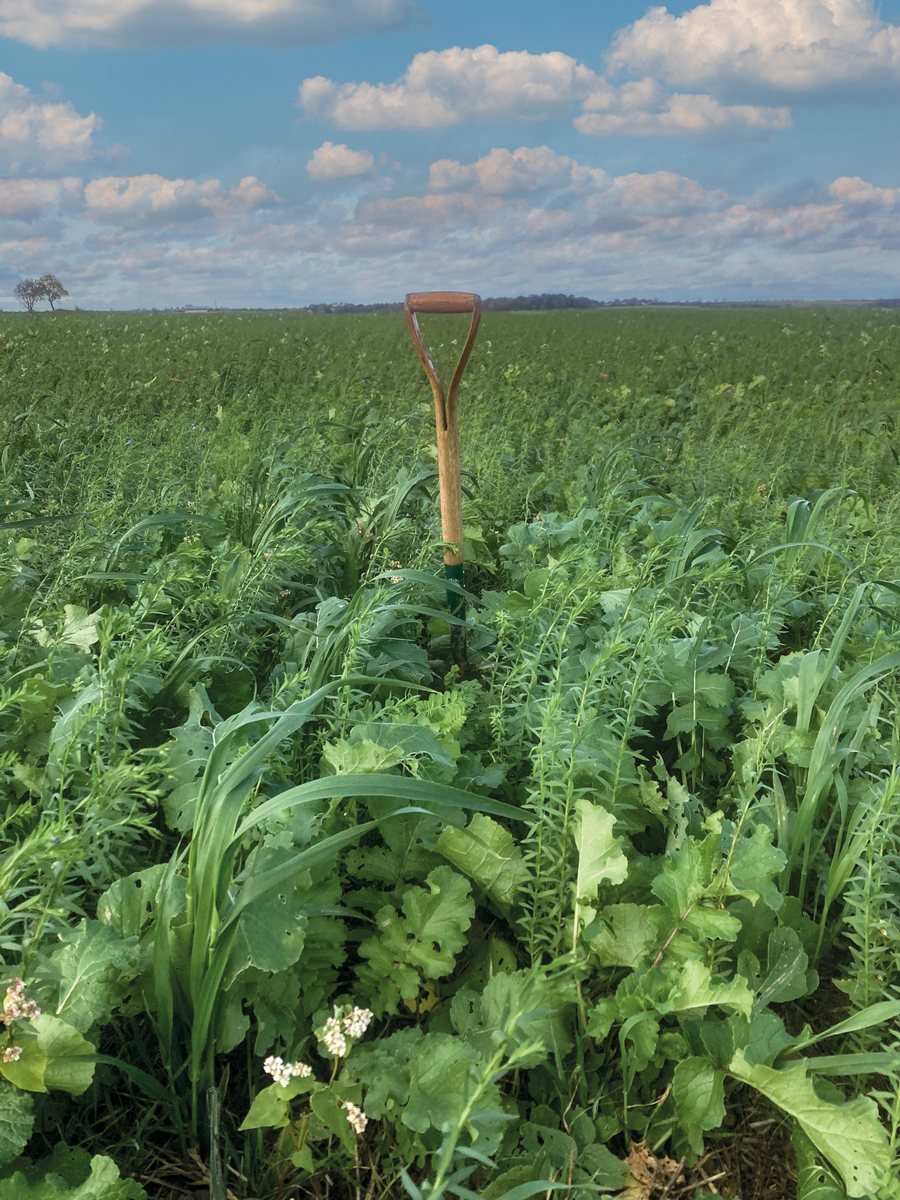Soil care and crop health – more than just tillage
24th December 2021
Changing from a conventional to strip tillage in 2019 was something of a baptism of fire for fourth-generation East Yorkshire grower Jonathan Hodgson.

Drilling winter wheat with the Mzuri.
Farm facts:
Growing area: 280ha home farm plus contract combining
Soil: Holderness clay, medium-bodied soil
Crops grown: First wheats, oilseed rape, spring oats, vining peas, beans,
spring malting barley, flaxseed, herbal leys
Livestock: High welfare pork
Diversification: Glamping, microbrewery, logs
Based about 13 miles east of Hull and just three miles from the North Sea, the farm has fertile, medium-to-heavy clay soils. With a focus on arable crops, the farm grows wheat for biscuit flour, breadcrumbs, seed and bio fuels, vining peas for Birds Eye, malting barley for its own brewery, spring oats, spring beans and flaxseed.
Mr Hodgson says: “We knew we could not continue in the same way as we had been, so we decided to make the move to strip till.
“As a result, farming has now gone from being dreary to something exciting.”
However, he reflects, he could not have chosen a worse year than 2019 to change, and he had no idea how the land would react. But he sold his conventional drill and cultivation equipment, and purchased a Mzuri drill and a stubble rake, determined to make a difference. Despite the wet autumn, Mr Hodgson managed to drill some winter wheat in 2019.
“In the first year, some crops were good, others not so, and in general the spring crops did better than autumn-sown ones because they were able to hold on to moisture better in a dry spring,” he comments.s
Now into his third year of strip till, he reports that he can really see the difference in the soil and that crops have improved.
He emphasises the learning curve, in particular when to drill and when not to drill.
“For example, we are now more patient in the spring, and adapt to the actual soil conditions rather than following the calendar,” Mr Hodgson shares.
Over the past two years other factors such as weather patterns have also come in to play.
“One of the challenges is that oilseed rape is a fickle crop. In 2020, because we had a late harvest, it was drilled late September. LG Aspire achieved a respectable 4.7t/ha and Nikita yielded 3.5t/ha.
“Winter crops which have been drilled this autumn look the best we have seen for many years, but there is a lot of growing to do yet.”
Mr Hodgson explains that the main aim of the change was to improve soil health, reduce the weed burden and try to reduce the need for inorganic fertilisers and pesticides. But all these things take time, he emphasises.
In particular, there are still some issues with black-grass, which he is working to address.
“As soils improve and drain better, theoretically, black-grass should become less of a problem – so it will be interesting to see how it progresses.”
Looking back at how the problem developed, he reflects that he relied on spring herbicides to keep on top of black-grass, but by leaving the resistant strains behind, the problem multiplied.
“Nature finds a way round chemicals, so we have been trying to think outside the box.”
Plans are to move to a mechanical weeder which slices the weed just below the surface. Timing will be key to success – as this will have to be done during a dry spell.
Since working on improving the farm’s soil health, Mr Hodgson has been able to reduce nitrogen rates by 10% without affecting average yields.
“Nutrition is not just about nitrogen, phosphate and potash, so we are now planning to send samples for sap analysis next spring to get a true picture of any deficiencies – or excesses – as a healthy plant is less liable to succumb to pests and pathogens.”
The only problem is that at the moment, the nearest laboratory capable of doing these tests is in the Netherlands.
Mr Hodgson is also carrying out Brix testing, which measures levels of sugar within the plant sap, which he learned about in Base-UK meetings.
The Brix tests are useful because sugar levels in a plant reflect photosynthetic activity and gauge of the health of the plant; healthy crops typically have levels above 12 and the higher the sugar levels, the healthier the plant.
“We now use amino acids and humic acids to kickstart growth by feeding the micro-bacteria in the soil at sowing time which then create synergies with the bacteria in the plant. This in turn helps the plant uptake and use the nutrients more efficiently.”
Recent fertiliser shortages may even spark innovation, such as better application techniques, he believes.
“We already know that uptake through the leaf is more efficient than in when fertiliser is placed in the soil, so there might be a move towards better methods of application to help maximise benefits.”
He has also moved away from using insecticides, as well fungicidal seed dressings.
“Looking at recent studies on fungicides, we need to question why we apply them if we want the plants to interact with soil fungi and optimise nutrition uptake.
“When soils work better, we now know the mycorrhiza will make them even better.”
Crops, companion crops and cover crops
Mr Hodgson has been incorporating some new crops into the rotation; for example, this year he grew flax, which was planted in April and harvested in July.
“We decided to try it because it has good interaction with the soil, and we were approached to grow it by a local processor.”
As he grows vining peas as part of a Birds Eye initiative, he has been doing trials on catch crops to try and trap nutrients within a plant and not have them leach through the soil profile – plus there’s the added bonus of having a living root growing at the height of summer.

Winter wheat drilled 9th October 2021.
This year, a catch crop was planted after vining peas, and he then direct drilled with winter wheat.
Mr Hodgson has also been working on plant companion crops for the oilseed rape, including the likes of berseem clover, buckwheat and vetch.
Using cover crops has been something of a learning curve, he reveals. He uses three- and four-way mixes, and when he has sheep to graze them, he goes up to a 10-way.
Help is at hand in the shape of a consultant farmer who has lots of experience in such projects – having made his move over 15 years ago, he is well qualified to guide the transitional path.
“The bigger the mix, the more diversity, which is better, but we still need to work out which are the best species for our soils as well as the cost of growing them,” says Mr Hodgson.
“We have found the best time to plant cover crops is early- to mid-August, drilling them into the stubble of the previous crop. However, this can be difficult. For example, in 2021, August was not a good month weather-wise, so they did not put on as much biomass as we would have liked, although roots were good.
“However, if cover crops are sown in September, they can struggle to gain biomass so will not grow very well.”
This year he was pleased with the spring beans which were planted after a cover crop of mustard, berseem clover, spring oats and tillage radish.
One of the challenges is that cover crops can increase slug pressure, which is something Mr Hodgson is working on finding
ways to address.
Variety choice
When it comes to choosing varieties to grow, the primary characteristic Mr Hodgson is looking for is stable resistance.
“As we are close to the sea, we are often challenged by Septoria tritici and yellow rust, so resistance is key for us.”
This year he drilled Group 4 wheat LG Astronomer into a catch crop with amino acids and humic acids down the coulter, and he reports it is looking good.
“We have found this variety to be sufficiently robust for the area, and we are trying out a small field of LG Typhoon to gauge how well it works in the different conditions.”
Other varieties grown on the farm include Costello, KWS Extase and Theodore.

Ten-way cover crop.
More than just soil cultivation
Finding and learning from other people on similar journeys has also proved to be an important source of wisdom, as they share ideas on how to improve, productivity, sustainability and profitability
he adds.
The farm has always had some sort of livestock, such as pigs and sheep, on the land, and Mr Hodgson is now looking to expand and purchase his own sheep.
“Soil is a living, breathing medium, and we are not only learning how a good, healthy soil should look and feel, but also how it will help us grow healthy and profitable crops.” FG
